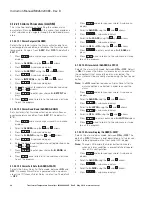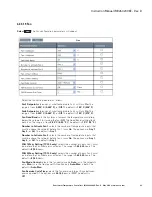
30
Instruction Manual IM02602008E - Rev. D
Transformer Temperature Controllers
IM02602008E - Rev. D May 2019 www.eaton.com
After the input state is selected five options are given
for the effect to occur when the input state occurs. The
options are
ALARM
,
TRIP
,
FAN2
,
FANS ON
, and
FANS
OFF
. The default is
ALARM
. The
FANS ON
and
FANS OFF
control both fans and override temperature setpoints, thus
they can be used to always force fans On or Off.
1. Press
Prog
and enter your password. A sub-menu
displays.
2. Scroll to
D-INPUT 1
using the
and
arrows.
3. Press
Select
. A sub-menu displays.
4. Scroll to
USER DEF
using the
and
arrows.
5. Press
Select
. A sub-menu displays.
6. Scroll to
DIRECT
or
INVERT
using the
and
arrows.
7. Press
Select
to enter your selection. A sub-menu
displays.
8. Scroll to
ALARM
,
FANS OFF
,
FANS ON
,
FAN 2
, or
TRIP
using the
and
arrows.
9. Press
Select
to enter your selection.
DIRECT
or
INVERT
displays.
10. Press
Back
once or twice to return to the sub-menus
or three times to exit the program.
4.1.2.2.17.4 Discrete Input 2 Fan Fail Selection (D-IPUT1/FAN
FAIL) (TC-100 Only)
Configures discrete input 2 as a user defined function.
This may be used with a wider array of external sensors or
switches to generate an alarm or trip condition, control the
fans, or even control other equipment using the Fan2 relay.
When selected, two options are given to define the relation-
ship between the input state and output state. The options
are
DIRECT
, which means a closure on the input results in
a closure on the output, or
INVERT
which means an open
on the input causes a closure on the output. This allows
the use of normally open or normally closed contacts on the
input. The default is
DIRECT
.
After the input state is selected five options are given
for the effect to occur when the input state occurs. The
options are
ALARM ONLY
, or
ALM+FAN1
. The default is
ALARM ONLY
. The
FANS ON
and
FANS OFF
control both
fans and override temperature setpoints, thus they can be
used to always force fans On or Off.
1. Press
Prog
and enter your password. A sub-menu
displays.
2. Scroll to
D--INPUT 2
using the
and
arrows.
3. Press
Select
. A sub-menu displays.
4. Scroll to
FAN FAIL
using the
and
arrows.
5. Press
Select
. A sub-menu displays.
6. Scroll to
OPEN
or
CLOSED
using the
and
arrows.
7. Press
Select
to enter your selection. A sub-menu
displays
8. Scroll to
ALARM ONLY
or
ALM+FAN 1
using the
and
arrows.
9. Press
Select
to enter your selection.
OPEN
or
CLOSED
displays.
10. Press
Back
once or twice to return to the sub-menus
or three times to exit the program.
4.1.2.2.17.5 Discrete Input 2 User Defined (D-IPUT2/USER
DEF) (TC-100 Only)
Configures discrete input 2 as a user defined function.
This may be used with a wider array of external sensors or
switches to generate an alarm or trip condition, control the
fans, or even control other equipment using the Fan2 relay.
When selected, two options are given to define the relation-
ship between the input state and output state. The options
are
DIRECT
, which means a closure on the input results in
a closure on the output, or
INVERT
which means an open
on the input causes a closure on the output. This allows
the use of NO or NC contacts on the input. The default is
DIRECT
.
After the input state is selected five options are given for
the effect to occur when the input state occurs. The options
are
ALARM
,
TRIP
,
FAN2
,
FANS ON
, and
FANS OFF
. The
default is
ALARM
. The
FANS ON
and
FANS OFF
control
both fans and override temperature setpoints, thus they can
be used to always force fans On or Off.
1. Press
Prog
and enter your password. A sub-menu
displays.
2. Scroll to
D-INPUT 2
using the
and
arrows.
3. Press
Select
. A sub-menu displays.
4. Scroll to
USER DEF
using the
and
arrows.
5. Press
Select
. A sub-menu displays.
6. Scroll to
DIRECT
or
INVERT
using the
and
arrows.
7. Press
Select
to enter your selection. A sub-menu
displays.
8. Scroll to
ALARM
,
FANS OFF
,
FANS ON
,
FAN 2
, or
TRIP
using the
and
arrows.
9. Press
Select
to enter your selection.
DIRECT
or
INVERT
displays.
10. Press
Back
once or twice to return to the sub-menus
or three times to exit the program.






























